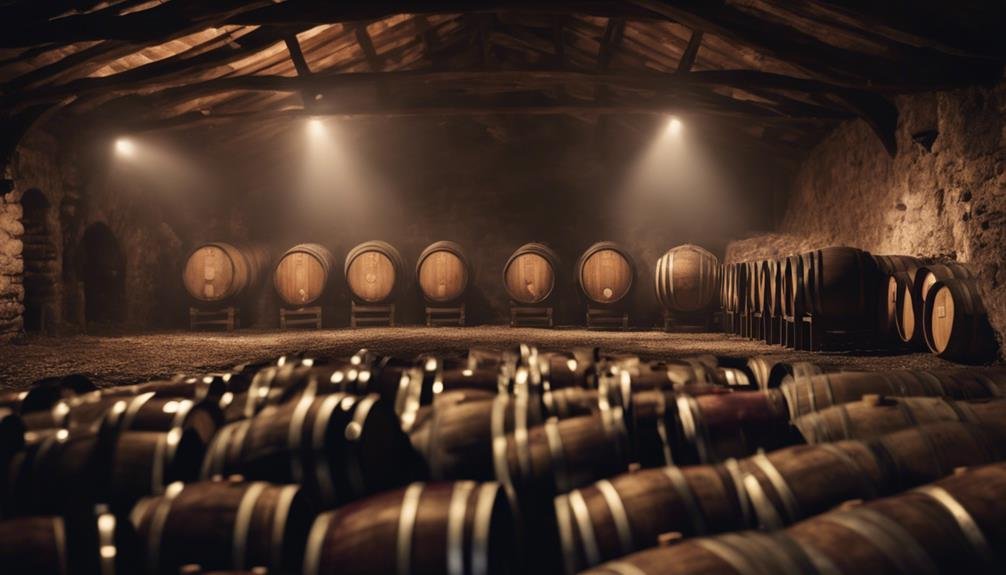Reveal the world of wine aromas by delving into vine metabolism, grape varieties, yeast impacts, fermentation processes, and the aging journey. From diverse aromatic compounds to unique varietal aromas, each element intertwines into the sensorial adventure awaiting wine lovers. Delight in the intricate dance of flavors shaped by vine metabolism, yeast strains, and oak barrels. Discover the aromatic symphony created by fermentation processes and the evolution of flavors during aging. Embrace the sensory voyage where every sip reveals layers of complexity and richness, inviting you to savor the artistry of wine craftsmanship. Decipher the secrets of wine aromas and embark on a tantalizing exploration.
Vine Metabolism and Aromas
Through vine metabolism, a diverse array of aromatic compounds is generated, contributing distinctive aromas to varietal wines. These aroma compounds play a vital role in wine aroma perception and sensory evaluation.
Varied aromas are created through the intricate processes of vine metabolism, leading to the development of unique scents in different wine grape varieties. Understanding the relationship between vine metabolism and aroma compounds is essential for discerning the complex bouquet of aromas present in wines.
Sensory evaluation techniques allow for the appreciation and analysis of these aromas, enhancing the overall wine-tasting experience. By delving into the intricacies of vine metabolism and its impact on aroma development, wine enthusiasts can deepen their understanding and enjoyment of the diverse range of aromas found in varietal wines.
Varied Aromas in Wine Grapes
A multitude of aromatic compounds present in wine grapes contribute to the diverse range of aromas found in varietal wines. Different grape varietals contain unique aroma compounds that impact the overall sensory experience of wine. Aroma perception and sensory evaluation play vital roles in identifying and appreciating these distinct aromas. By understanding the specific aromas associated with each grape varietal, wine enthusiasts can enhance their tasting experiences and develop a deeper appreciation for the complexities of wine. To illustrate this point visually, consider the following table showcasing some common grape varietals and their characteristic aroma compounds:
| Grape Varietal | Aroma Compounds |
|---|---|
| Moscato Bianco | Monoterpenes |
| Gewürztraminer | Monoterpenes |
| Sauvignon Blanc | Methoxypyrazines |
| Syrah | Sesquiterpenes |
Understanding the relationship between grape varietals and aroma compounds is essential for discerning wine connoisseurs seeking to unravel the intricacies of wine aromas.
Influence of Yeast in Aromas

The intricate relationship between grape varietals and their characteristic aroma compounds extends to the influence of yeast in shaping the aromatic profile of wines.
Key Points:
- Yeast Strains: Different yeast strains used in fermentation can produce unique aromatic compounds, influencing the final aroma of the wine.
- Aromatic Compounds: Yeast fermentation plays a vital role in the formation of various aromatic compounds, such as esters and thiols, which contribute to the sensory perception of wine.
- Sensory Perception: The interaction between yeast and grape components during fermentation impacts the sensory experience of wine drinkers, influencing the overall aroma complexity and quality of the wine.
Understanding the role of yeast in aroma development is essential for appreciating the diverse range of aromas found in wines produced worldwide.
Aromas From Fermentation Processes
During the fermentation process, various aromatic compounds are generated that contribute significantly to the complex sensory profiles of wines. Aromatic compounds interact to create a wide array of scents, enriching the overall aroma development during fermentation.
Yeast, particularly Saccharomyces cerevisiae, plays a vital role in producing esters that add fruity notes, while bacteria involved in malolactic fermentation contribute buttery and toasty aromas. Compounds like acetoin and diacetyl introduce sweet buttery smells, and ethyl esters bring flavors reminiscent of apple, banana, and pineapple.
These compounds can interact and combine to form new flavors during the fermentation process, enhancing the diversity and complexity of aromas found in wines.
Fermentation aroma development is a fascinating aspect of winemaking that showcases the intricate chemistry behind the creation of distinct wine bouquets.
Impact of Aging on Aromas

Aging in wine production greatly influences the aromatic profile, enhancing the complexity and depth of flavors.
- Oak Influence: The type of oak barrel used during aging imparts specific aromas to the wine, such as vanilla, spice, or toast, enhancing its overall bouquet.
- Chemical Reactions: During aging, chemical reactions between compounds in the wine lead to the development of new flavors and aromas, contributing to the complexity and richness of the final product.
- Flavor Complexity: Over time, wines can develop a wide range of aromas, from fruity and floral notes to earthy and spicy undertones, adding layers of complexity that enhance the overall tasting experience.
Frequently Asked Questions
How Do Different Grape Varieties Affect Wine Aromas?
Different grape varieties influence wine aromas through their unique biochemical composition. Factors like soil influences and microbial interactions shape metabolites that produce distinct scents. This interplay of nature and nurture results in a diverse array of aromatic profiles in wines.
Can Aging Wine in Different Types of Wood Barrels Change Its Aroma Significantly?
Aging wine in different types of wood barrels can notably change its aroma due to the oak influence and aromatic transformation during barrel aging. This process leads to an evolution of aromas, influenced by the wood's characteristics.
What Role Do Esters Play in Creating Complex Wine Aromas?
Esters, produced during the fermentation process, contribute to the complexity of wine aromas. These fruity compounds enhance aroma perception, influencing sensory evaluation. Understanding their role in creating diverse aromas enriches the experience of wine appreciation.
Are There Any Unique Aroma Compounds Found in Specific Grape Varietals?
Unique terpenes are prevalent in specific grape varietals due to grape genetics. These compounds, like monoterpenes, methoxypyrazines, and sesquiterpenes, contribute to distinct aromas in wines such as lychee, green pepper, and black pepper, showcasing the diversity of grape aromatics.
How Do Temperature and Oxygen Exposure Impact the Development of Wine Aromas?
Temperature control is a vital element in the evolution of wine aromas, as it influences the rate of chemical reactions. Oxygen exposure can either enhance or diminish aroma development, impacting the complexity and balance of a wine's bouquet.
Conclusion
To sum up, the intricate world of wine aromas reveals a rich tapestry of flavors woven by vine metabolism, fermentation processes, and aging techniques. Each aroma tells a story of grape variety, production methods, and aging conditions, creating a symphony of sensory delights waiting to be savored.
From Monoterpenes to Sesquiterpenes, the alchemy of chemical reactions and wood influences harmonize to expose a world of aromas in each glass of wine. Embrace this sensory adventure and appreciate the beauty of wine aromas.
